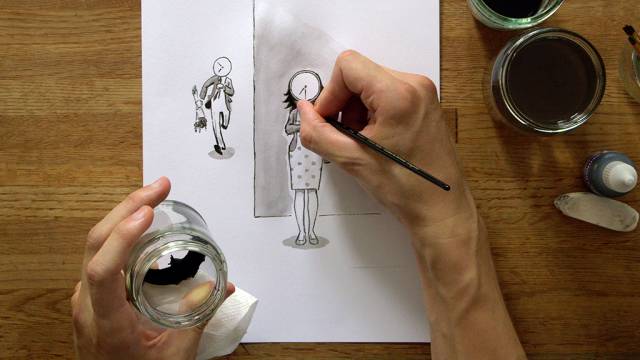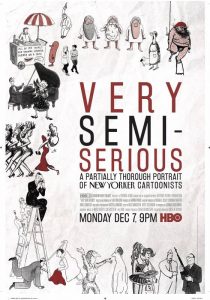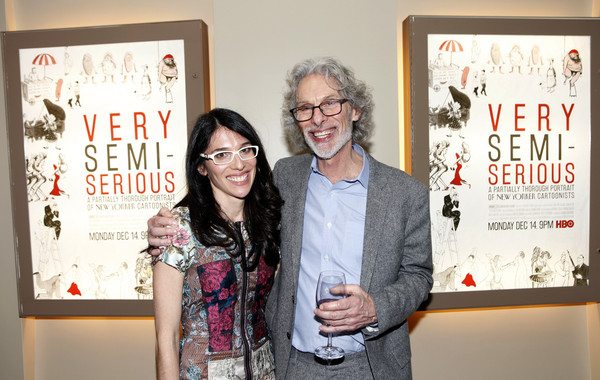
 In Very Semi-Serious, director Leah Wolchok takes us inside the Cartoon Department at The New Yorker to paint a portrait of the legendary cartoonists whose work has served as barometers for the mood of American society for decades. Central to the film, is the role of Bob Mankoff, The New Yorker’s Cartoon Editor since 1997, who has steered the department into the 21st century by creating interactive platforms between the magazine’s readers and the cartoons with tools like the weekly caption contest and others.
In Very Semi-Serious, director Leah Wolchok takes us inside the Cartoon Department at The New Yorker to paint a portrait of the legendary cartoonists whose work has served as barometers for the mood of American society for decades. Central to the film, is the role of Bob Mankoff, The New Yorker’s Cartoon Editor since 1997, who has steered the department into the 21st century by creating interactive platforms between the magazine’s readers and the cartoons with tools like the weekly caption contest and others.
Mankoff himself is responsible for one of the most popular cartoons to come out of the magazine, he even used a segment of the caption to name his autobiography, How About Never: Is Never Good For You? My Life in Cartoons. In the film, Mankoff comes across as a charming, wise leader who serves as both challenger and nurturer of the cartoonists under his wing. We had the opportunity to talk to Mr. Mankoff about the pros and cons of being in the spotlight, what he’s looking for in cartoons and who he thinks would be the perfect actor to play him in a biopic.
It never crossed my mind that we would ever get such an in-depth look at how The New Yorker cartoons get made, was it strange to have someone approach you about wanting to make a film about your work?
It wasn’t the first time people had looked at this, going back to 1997 when I first became Cartoon Editor there was a Nightline with ted Koppel feature called “Drawing Laughter”, which was a half hour show, so people had kinda seen the process. There was also a 60 Minutes feature, but Very Semi-Serious is much deeper, much more nuanced, look. Director Leah Wolchok truly came to know me and the cartoonists well, it wasn’t about “here’s the people who do this”, it was more about getting into the lives of these people. I thought that was important and made the feel deep and interesting.
 In the film you talk about how you submitted 500 cartoons before the first one was even published, now that you’re running the cartoon department have you found that you cut back on drawing?
In the film you talk about how you submitted 500 cartoons before the first one was even published, now that you’re running the cartoon department have you found that you cut back on drawing?
Absolutely, over the years I’ve drawn less, my goal now is to mentor and bring in a new generation of people. To everything there is a season, I started cartooning in my 30s, I’m 71 now and I’ve drawn a lot of cartoons and still do every once in a while. But the big kick that comes across in the film is the generational shift and the integration of the generations, I view that as what I do, I mentor, I encourage, I’m a therapist (laughs), I’ll tape their ankle if they sprain it. My job became a different one over time, but one that’s pretty exciting.
Do you ever begin pitch days knowing exactly what you’re looking for? Or do you let people surprise you?
I never have an idea of what I’m looking for, the thing that defines The New Yorker is the complete eclecticism and variety of the approaches to creating cartoons, that whole thing becomes what people think of as a The New Yorker cartoon, there’s always something inherently familiar and surprising about the cartoons. I’m always looking to be surprised and new things, in the film for instance you see me looking at Liana [Finck] trying to peer through the personality embodied in her cartoons to see what’s there; is there something for us and is there something for her? I think she’s flourished especially after the film.
This might not mean much but I renewed my subscription to the magazine the day after I saw the film.
(Laughs) That’s great! I’ll make sure to tell David Remnick that, so put it wherever you’re writing.
I used to have a subscription before and watching the movie I remembered how much I loved saving the cartoons for last.
That’s interesting, your procedure is different to that of most people then. Most people go through the cartoons first. It must be a little bit hard though, because if you’re reading the articles, the cartoons are there. You can do it though, because you can see the image, but then have to make a little bit of a concerted effort to read the caption.
Which brings me to my next question, you initiated the caption contest and watching the film it made me think of how the democratic process of having someone do the caption and someone else do the illustration, is very much like the Hollywood studio system method which was about teamwork.
Cartoons used to be team efforts going back to that exact same era in Hollywood, there were people called “gag writers” who wrote the jokes and then there were the cartoonists. That changed in the 60s and 70s when the editor at the time wanted more authenticity, things like singer/songwriters like Bob Dylan, so he had the cartoonists do the whole thing. The caption contest is meant to let all our readers play the game.

Have you heard of any caption contest entrants who then draw their own cartons?
Most cartoons in the contest are sub-species of cartoons, they’re “caption contest” cartoons, they’re kind of like a comic puzzle you have to solve, rather than a real cartoon with meaning of any sort. Our latest cartoon has two racers, one is riding a horse, the other is riding a seahorse, so there are so many “solutions”, things like “it’s O.K. Corral not O.K. Coral”, they’re not necessarily great cartoons, but they’re examples of real comic ingenuity on part of the captioneers.
They’re also all winners too, since they captioneers get to exercise their brain.
Now I’m crowdsourcing and working with data scientists at the University of Wisconsin, right now they’re judging and rating the cartoons, we’re making the process even more democratic.
Do you find that having your memoirs out and now having the movie on HBO will mean that people will know way too much about you?
That can be a little funny, it happened last year with the 60 Minutes episode about the book. I traveled a lot for the book around the time of the episode, so one time I was sitting in an airport and wondered why was this young woman looking at me, an old guy. I thought “well that hasn’t happened in a long time” (laughs) and then I remembered 60 Minutes. People would come up to me, or even weirder, I’d be in a cab or in the street and people would come up and ask where they knew me from. They usually got it wrong. I imagine this might happen with the film on HBO, but this happens just for a little bit and then it goes away. To be famous in this country you have to be constantly in the spotlight. When it goes away you’re a little disappointed though, you think someone recognized you and it turns out they’re waving to their friend behind you (laughs). I think I get credit for some of the things I’ve done, but also for the magazine’s history and the great writers who work on it, so people project on to me this wonderful veneer of The New Yorker when really I’m a kid from Queens who was lucky enough to earn his living doing something.
On the topic of becoming famous, who would play you in a biopic?
(Laughs) It’s definitely Jeff Goldblum! He’d be perfect, he’s sort of funny and serious, I can definitely see him play me. So call Jeff up!
Very Semi-Serious premieres on HBO December 14.